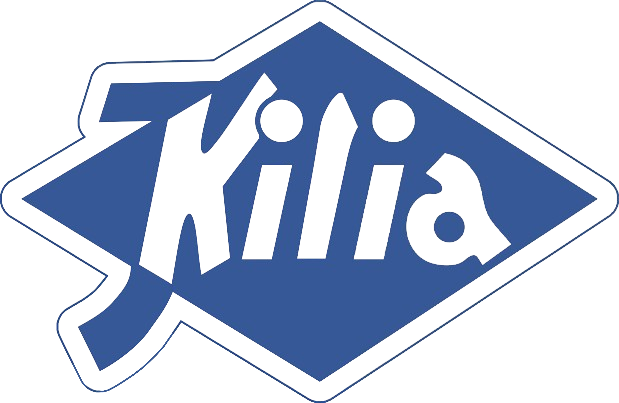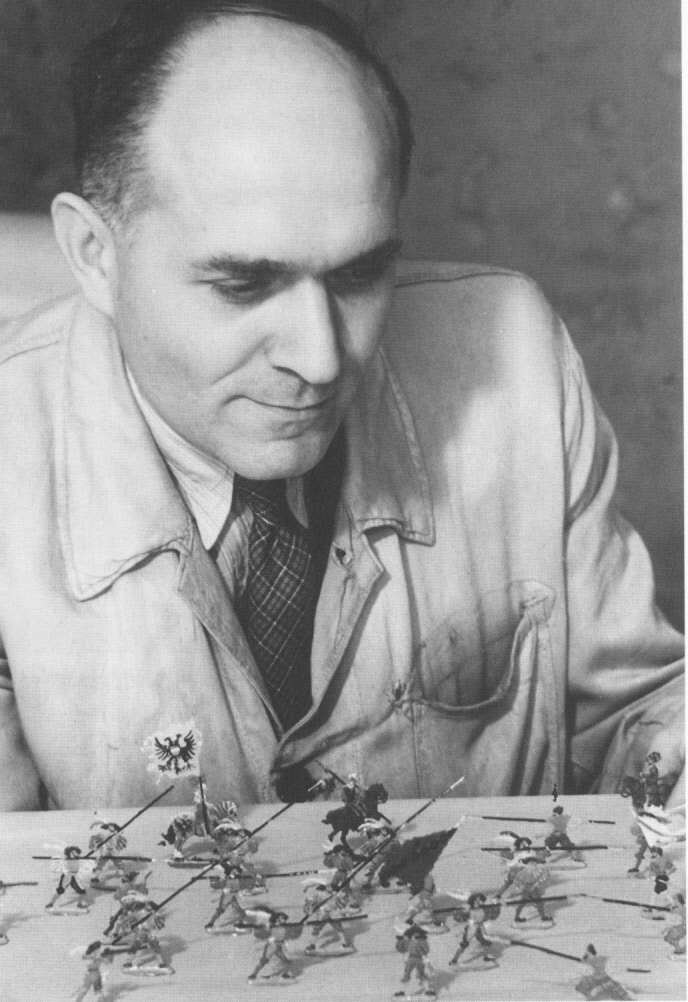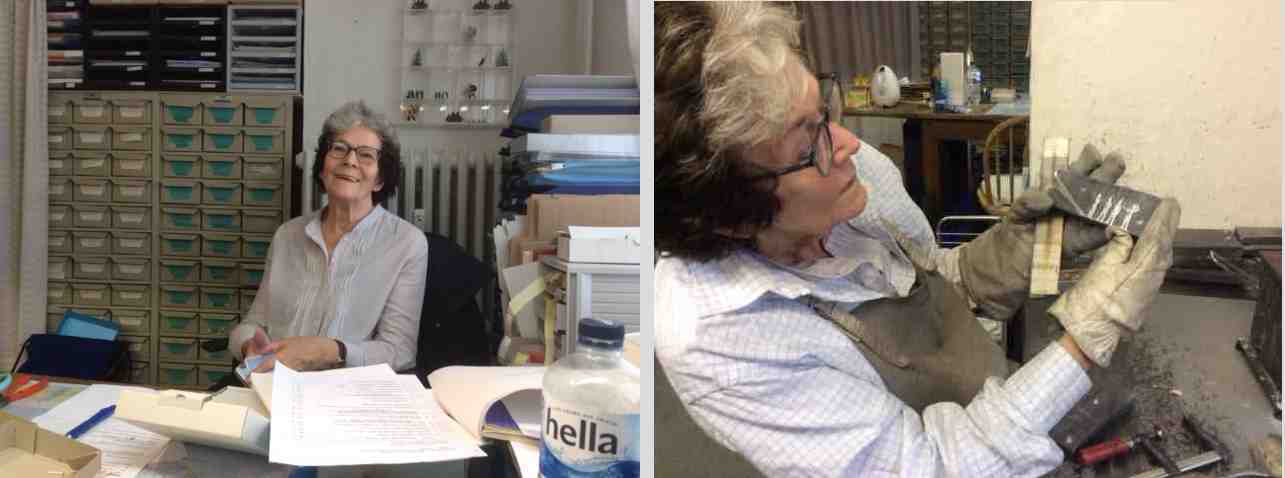 - Kieler
Zinnfiguren - from the manufactory of Marbod
Gerstenhauer -
- Kieler
Zinnfiguren - from the manufactory of Marbod
Gerstenhauer -
History
Chronology of the Kiel tin figure factories
1924
a group of tin figure collectors whose names are no longer known today founded the "Factory for Historical Tin Figures and Cultural Images G.m.b.H.". The collector and reserve officer Max Hahnemann, who was already known before the World War, was appointed as managing director from among their circle. The newly founded company has its registered office and production facility in Kiel, Jungmannstraße 24.
From this point on, the Kiel dealership produces pewter figures according to a high historical and handicraft standard in two quality levels:
Brand HIZ - "Fine metal and accurate historical painting"
Brand BIZ - "Simple alloying and painting."
The figures were almost exclusively painted and sold in series and battle packs to buyers and interested parties,
from whom an organized group of collectors developed in Germany and other European countries during these years.
1926/27
the first main list appears with the index of the figures published up to this point in time.
1927
The merchant Aloys Ochel, born in Kiel in 1906, joins the fast-growing company as managing director, which has already been closed by the original shareholders.
1928
Relocation to the "Eichhof" industrial block in Kiel. Under the direction of Hahnemann and Ochel, the factory is constantly trying to expand and update its program and range by developing new themes. The release of the ship model series will start this year.
1929
a large Kiel tin figure exhibition opens in the "Europa-Haus" in Berlin, Königgrätzer Strasse. In 22 large dioramas, designed exclusively with pewter figures from Kiel, the epochs of world history are presented from the beginning to the present.
1931
The company moves to Fleethörn 29 in Kiel. In the years that followed, the Kieler Zinnfiguren appeared under the name "Kieler Zinnfigurenfabrilk G.m.b.H.".
1932/33
Like most companies at this time of the global economic crisis, the Kieler Zinnfigurenfabrik also got into great economic difficulties. In order to at least save the mold stock at a later date, but also to secure his own existence, Aloys Ochel leaves the company and strives to found his own company.
1933
The new Kiel tin figure factory is founded under the name "Kieler Zinnsoldaten A. Ochel". Aloys Ochel continues the good traditions of the "old Kieler company". The pewter figures in his factory painting also appear in two categories:
KILIA - KILIA - High-quality figures in careful painting.
OKI - OKI - Simple painting.
At the same time, however, he announces that blank figures can also be obtained.
1933
In the fall, Max Hahnemann had the Klio magazine "Die Zinnfigur" publish that he was leaving the company he had previously managed and joining the new company under Aloys Ochel.
1935
new releases from the "Kieler Zinnfigurenfabrik" will still be offered up to this point in time. In the first year the two companies existed side by side, there were actually significantly more new releases than those of the company newly founded by A. Ochel. Towards the end of 1935, however, all production officially ceased.
1936
Ochel announces in the trade journals that he will take over the molds from the old company in Kiel and that the figures can be purchased from him as usual.
After 1940
are no longer officially supplied to private customers, mainly due to the lack of material as a result of war and armaments production. Larger orders for the Wehrmacht, the so-called sandbox figures, are mentioned several times in the literature, but could not be confirmed, or at least not to the extent assumed.
1943
After the first Anglo-American air raids on Kiel, the stock of molds and part of the company archive are moved to a former slaughterhouse in Preetz, in the district of Plön.
1944
The company building is hit in a heavy air raid on Kiel and burns out completely. The part of the company archive that was not outsourced was also destroyed with the original drawings for almost all eras.
1946
After the end of the Second World War, production resumed relatively quickly, despite the continuing shortage of raw materials and temporary reservations about the pewter figure due to its reference to military traditions. The company name was changed to "Kieler Zinnfiguren A. Ochel" and the range of figures was also geared more towards civilian themes. After the end of the war, Aloys Ochel moved into the company premises at Brunswicker Straße 7 in Kiel, later at Feldstraße 24.
ab 1950
The range of figures from the Kiel company is significantly expanded through the development of new themes, through a large number of new engravings and the adoption of the stock of forms from other publishers, such as Bruno Hinsch, Hamburg. When Aloys Ochel withdrew from the business at the beginning of the 1970s, his company delivered around 10,000 different figures, cast from around 4200 molds in more than 1500 serial packs, to collectors all over the world. Since the Heinrichsen company in Nuremberg did not resume production after the war and other shops such as Rieche in Hanover and Zeumer in Dresden fell victim to the bombing raids, the Kiel company was the most important company producing pewter figures in Germany until it was closed.
1953
Aloys Ochel is one of the initiators and founders of the Kulmbach tin figure exchange. The annual fair quickly developed from a regional meeting to the most important event for the international collectors' world. Last but not least, this success is due to the great reputation that the Kieler pewter figures and Aloys Ochel enjoyed and still enjoy today among pewter figure collectors around the world, even before the war and to an even greater extent afterwards.
1957
Ludwig Frank dies in Nuremberg. His death is a grievous loss to the collectors and publishers for whom the most prolific master engraver known in the history of pewter figures has created thousands of new types. The loss also hit the Kiel company hard, since Ludwig Frank had worked for the company since it was founded in 1924. However, Aloys Ochel had had the courage early on to give orders to draftsmen and engravers who were still young and still developing. So we can state today that about 60 draftsmen and engravers made a contribution to the development of the Kiel pewter figure over the course of time.
1972
After the daughter of Aloys Ochel, Erika, married Kroschewski, had looked after the company for a long time, she took over the management of the company this year according to the entry in the commercial register of the district court in Kiel. For almost two decades she has been working for the company in the spirit of Aloys Ochel, safeguarding the extensive stock of shapes despite some difficulties, even expanding it, especially with handicraft motifs, and ensuring that collectors in Germany and many other countries can continue to purchase Kiel pewter figures.

1979
Aloys Ochel dies in Kiel.
1991
the company moves to Kiel, Schülper Baum 23.
1993/94
Erika Ochel decides to have a large part of the molded stones restored by the Schmittdiel workshop, since a large part of the molds have suffered greatly over the course of several decades and it is therefore often no longer possible to deliver flawless casts. At the same time, the collector Fritz Hüther begins to precisely record the forms and the figures. On this basis, the first comprehensive figure catalog of the Kieler pewter figures is created. During his work, Fritz Hüther discovered a number of previously unrecorded figures, which were presented to collectors for the first time in this context. The work will be completed in October 1994 and after that there will be 4217 molds in the Kiel company at this point in time.
1997
the Kieler pewter figures are represented for the last time at an international pewter figure fair in Kulmbach. During the stock exchange, the collectors received the message from Erika Ochel that the company would cease operations at the end of the year. To the regret of the international collector world, this became a reality. Since December 1997, after more than six decades, the Kiel tin figure company no longer exists.
2009
ian internet presence was launched in the spring and production resumed in the small, private setting of Erika Ochel; you could also find them again at the Kulmbacher Zinnfigurenbörse.

2019
in November the Kieler Zinnfiguren were taken over by Marbod Gerstenhauer. The more than 4000 molds were carefully packed and transported to Weimar. Production will continue there.
2022
Erika Ochel dies on November 3rd.
Slightly modified and supplemented, this text comes from the book: Kieler Zinnfiguren, Volume II by Dr. Egon Krannich. Edition Krannich 2003. 04668 Grimma, Schlossgasse 4, ISBN 3-933124-15-8
Text supplements and websites: Dr. Werner Lehnberg, pictures: Aloys Ochel by unknown, Erika Ochel by Agathe Rumohr
